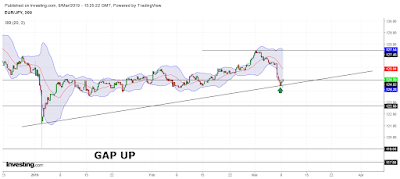At first glance, we can notice a volatility exhaust: there is a repulsion from the previous top (0% FIBO level); the commodity is in the upper line of the BBs, then the RSI shows an overbought momentum (the red line crosses from above to below the higher limit at about 70.00).
The bullish impulse seems to stop (see the white candles): anyway, it represents just a break in the uptrend; for this reason, look at the parallel channel that clearly highlights the bullish trend (mid/long time frame); there was only a sideways interlude (light-blue rectangle).
About that, the rectangle pattern is a reference area useful to set up a trading strategy, respectively short with the break of the same or long if the area stays immaculate (in other words, accumulation area with target the previous maximums). The middle area (so mentioned) is limited also by the 23.60% FIBO level and 61.80% FIBO level (look at the green and red arrows).
Not randomly, the 23.60% FIBO level is limited by the yellow line: this last one is the median value of the real body (long white candle); generally, it is a strong reference.
 |
| Chart from Markets.com |
The situation is the same if we analyze the following chart: the slope, the direction and the intersections of EMA bundle (9, 20, 40) show the market direction and trend; bearish, bullish with the parallel channel (with a lateral trend, see the rectangle), then volatility exhaust.
Another signal is given by the MACD: we are near the crossover of the signal line with the MACD.
 |
| Chart from Markets.com |
Lastly, if we consider a different time frame (240), it is just a confirmation of what is said above: there is the bullish trend with a break due to the volatility exhaust; there is an additional reference, at about 2616 (the top of the white candle and the last minimum).
We need to monitor the next trading sessions: at present, the trend is bullish of course with a small discharge of the strength of the buyers.
 |
| Chart from Markets.com |
















